人教版七年级下册英语 Unit 12教案 Unit 12 教案
- 格式:doc
- 大小:101.01 KB
- 文档页数:13
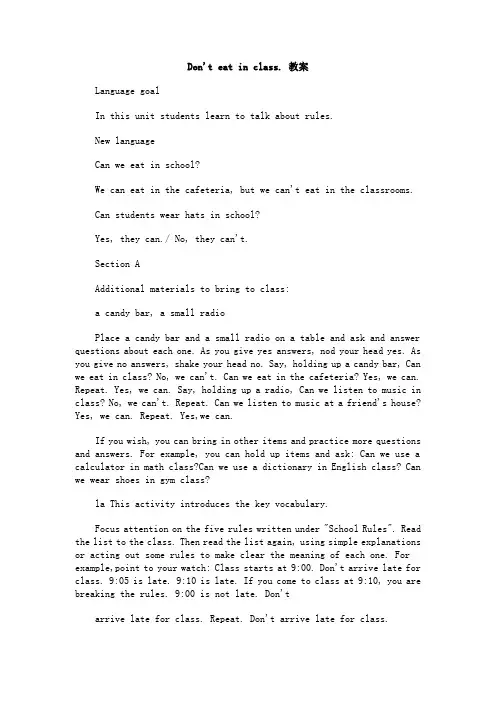
Don't eat in class. 教案Language goalIn this unit students learn to talk about rules.New languageCan we eat in school?We can eat in the cafeteria, but we can't eat in the classrooms.Can students wear hats in school?Yes, they can./ No, they can't.Section AAdditional materials to bring to class:a candy bar, a small radioPlace a candy bar and a small radio on a table and ask and answer questions about each one. As you give yes answers, nod your head yes. As you give no answers, shake your head no. Say, holding up a candy bar, Can we eat in class? No, we can't. Can we eat in the cafeteria? Yes, we can. Repeat. Yes, we can. Say, holding up a radio, Can we listen to music in class? No, we can't. Repeat. Can we listen to music at a friend's house? Yes, we can. Repeat. Yes,we can.If you wish, you can bring in other items and practice more questions and answers. For example, you can hold up items and ask: Can we use a calculator in math class?Can we use a dictionary in English class? Can we wear shoes in gym class?la This activity introduces the key vocabulary.Focus attention on the five rules written under "School Rules". Read the list to the class. Then read the list again, using simple explanations or acting out some rules to make clear the meaning of each one. For example,point to your watch: Class starts at 9:00. Don't arrive late for class. 9:05 is late. 9:10 is late. If you come to class at 9:10, you are breaking the rules. 9:00 is not late. Don'tarrive late for class. Repeat. Don't arrive late for class.Point out the students in the picture and the boxes next to them. Say, Each of these students is breaking one of these rules. Write the number of the rule each student is breaking in the box next to him or her. Point out the sample answer.Check the answers.1 b This activity gives students practice in understanding the target language in spoken conversation.Point to the five rules in activity la. Ask a different tudent to read each rule to the class.Point to the picture. Ask different students to say the ules that the students are breaking in the picture.Say, This conversation tells about three students. The students are breaking rules. Point out the direction line and the space after each name. Say, Write the number of the rule next to the name of the student who is breaking that rule.Play the recording the first time. Students only listen.Play the recording a second time. As they listen to the recording this time, students fill in the number of the rule after each name.Correct the answers.1 c This activity provides guided oral practice using the target language.Point out the example conversation. Ask two students to read the dialogue to the class.Say, Now work with a partner. Student A is from another country. He or she doesn't know the rules of this school. Student B tells him or her the rules from activity la.As the pairs talk, move around the room monitoring their work. Offer language or pronunciation support as needed.Ask several pairs to present one or more of their conversations to the class.Say, Now let's talk about the rules of our school.Student B is from another country. Student A tells him or her about the rules of our school.Again, move around the room monitoring progress and offering help as needed.2a This activity gives students practice in understanding the target language in spoken conversation.Point to the picture in activity 2a. Ask students to tell what they are doing. (They're talking.)Say, Listen to their conversation. They're talking about school rules.Play the recording the first time. Students only listen.Say, Now listen again. This time, put a checkmark next to the activities they're talking about. Point out the sample answer.Play the recording a second time. Students put checkmarks next to the activities they hear.Correct the answers.2b This activity provides further listening practice using the target languagePoint out the list of can and can't in the chart in activity 2a.Say, Now listen to the recording again. This time,circle can or can't to show which things Alex and Christina can and can't do at their school. Point out the sample answer for number 1.Play the recording and have students circle the answers.Correct the answers.2c This activity provides guided oral practice using thetarget language.Point out the sample conversation and have a pairo students read it to the class.Say, Now work with a partner. Student A is Alex am student B is Christina. Alex tells Christina about the rules at your school Change roles so that both of you practice both parts.As students work in pairs, move around the room monitoring progress and offering assistance, if needed.Ask some pairs to present their conversations to tha class.3a This activity introduces more key vocabulary.Call attention to the three pictures. Read the sentences in the speech bubbles, saying blank each time you come to a blank line.Then point to the three words. Say the words and ask students to repeat each one.After that, ask students to fill in the blank in each picture with one of the words from the box. As students work, move around the room answering questions as needed.Check the answers.3b This activity provides oral practice using the targetlanguage.Point out the conversation in the speech bubbles and ask two students to read it to the class. Ask students to explain what have to means. (It means something is necessary. It must be done. You have no choice about it.)Ask several pairs of students to read the conversation to the class.Say, Now please change some of the words and make your own conversations. Ask and answer questions about the rules of this school. Give true answers.Ask pairs of students to make up their own conversations. Move around the room offering language support as needed.Ask some pairs to present their conversations to the class.4 This game provides oral practice using the target language.Say, You will write down six rules. What rules can you think of? Remember to use can and have to.Write some responses on the board.Then say. Work on your own. Write a list of six rules. You can use the ones on the board or other ones we have talked about.When students have finished writing their lists, have them put their papers in a bag. Without looking, they take another paper from the bag.Say, Now go around the room. Ask if people can do the things on your list. Find the person who has the list of rules that you wrote. Allow ten minutes for students to find who have their lists.Ask some students to read their lists to the class.Answer any questions other students have about the lists.You may wish to write some new items on the board so students can learn new words.Alternatively, if you would prefer not to have your students more around the room, you can ask them to do this activity in groups of four.Section BNew languagemore action words: arrive, bang out, go out, clean,be home1 This activity introduces more key vocabulary.Focus attention on the four pictures. Ask students to ell what they see in each picture, using whatever words hey can. If necessary, supply the words or sentences and sk the class to repeat. Say a sentence or two about each icture. What's he doing? He's doing homework.Repeat. He's doing homework. The class repeats.Point out the list of rules. Say each rule and ask students to repeat. .Then ask students to match each rule with one of the pictures. Say, Write the letter of each picture on the blank line in front of one of the rules. Point out the sample answer.Check the answers.2b This activity provides listening and writing practice using the target language.Say, This time, please put a checkmark under Emily or Dave after each rule that Dave has at his house 'and each rule that Emily has at her house. Point out ,the sample answer.Play the tape again and have students make check- J marks. You may wish to play the tape more than once at this point.2a This activity provides listening and reading practice using the target language.Say, Now listen to a conversation between Dave and Emily. Listen carefully to their questions and answers.Play the tape. Students only listen.Say, Now number the rules in the order Dave and Emily talk about them. The first rule Emily talks about is Don't go out on school nights. The number 1 is in the blank in front of that rule to show that it is the first rule that Dave and Emily talk aboutPlay the tape again. This time students write in the numbers 1-4 as Dave and Emily talk about each rule.Check the answers.2c This activity provides guided listening and speaking practice using the target language.Say, Now talk about the rules in your house. What ,can and can't you do? What do you have to do? Word with a partner.As students talk, move around the room, monitoring conversations and offering language support as needed.Have some pairs of students present their conversations to the class.3a This activity provides reading practice using the target language.Call attention to the letter and point out the opening, Dear Dr Know. Explain that this is a letter to a newspaper writer. Zhao Pei is writing to get some advice.Read the letter to the class or ask a student to do this.Answer any questions students may have.Ask students to work alone. Have students read the letter and write the numbers 1 through 8 in front of the senF fences that talk about rules.Then ask students to write the rules on the blank Hnes next to the letter.3b This activity provides guided writing practice using the target language.Call students' attention to the pictures. Ask different .students to explain what the pictures mean.Point out the sample answer. Say, Now you have to write rules to match the rest of the pictures.Students do the activity individually. As they work,move around the classroom monitoring progress and offer help as necessary.Check the answers.3c This activity provides personalized writing practice using the target language.Say, Now write a letter to Dr Know. Tell Dr Know about the rules in your house. Remind students that they talked about these rules in activity 2c.Ask several students to read their letters to the class.4 This activity provides listening, speaking, reading and writing practice using the target language.Ask students to make a list of the rules in their houses.Have the students use Zhao Pel's list of rules as a model.Have some students read their lists to the class.Make language corrections as needed.Point out the sample question and answer in the speech bubbles. Ask two students to read it to the class.Ask students to move around the room and ask each other questions. Their job is to find other students who have the same rules.When student A finds another student with the same rule, student A writes the other student's name next to that rule on his or her list.You may wish to do a quick check to see which rules are most common.Alternative: If you would prefer not to have your students move around the room, you can ask them to do this activity in groups of four. They survey the other members of their group to find who has the same rules as they do.。
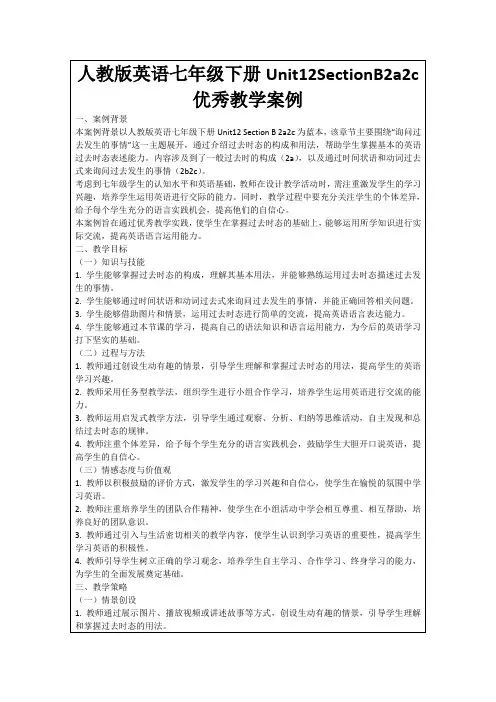
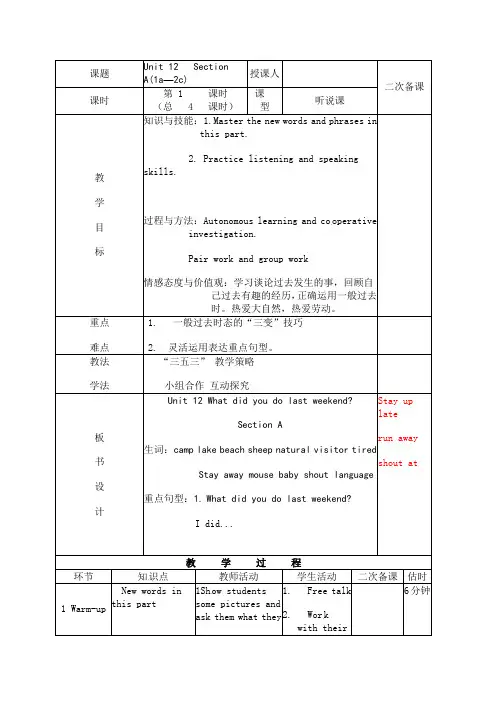
课题Unit 12 SectionA(1a—2c)授课人二次备课课时第 1 课时(总 4 课时)课型听说课教学目标知识与技能:1.Master the new words and phrases in this part.2. Practice listening and speaking skills.过程与方法:Autonomous learning and co operative investigation.Pair work and group work情感态度与价值观:学习谈论过去发生的事,回顾自己过去有趣的经历,正确运用一般过去时。
热爱大自然,热爱劳动。
重点难点1. 一般过去时态的“三变”技巧2. 灵活运用表达重点句型。
教法学法“三五三”教学策略小组合作互动探究板书设计Unit 12 What did you do last weekend?Section A生词:camp lake beach sheep natural visitor tiredStay away mouse baby shout language重点句型:1.What did you do last weekend?I did...Stay uplaterun awayshout at 教学过程环节知识点教师活动学生活动二次备课估时1 Warm-upNew words inthis part1Show studentssome pictures andask them what they1. Free talk2. Wor kwith their6分钟can see.2.Teach the new wordspartner3. Learn thenewwords2 Pre-task Phrases andsentences in thispart1. Let thestudents matchthe words withthe foods in1a.2. As k thestudents tolisten to therecordercarefully.3. Ask them reada fterthe recorder.1. Match thewordswith thepicturesin 1a.2. Listen to therecordercarefully3. Readtogether.一般过去时态的“三变”技巧Work asSheep单复数同行10分钟3 While-task conversations Make a newconversationaccor ding to 1aMake a newconversationwith theirpartners8分钟教学过程环节知识点教师活动学生活动二次备课估时4 Post-task ListeningSpeakingWriting1. Ask thestudents tolisten to therecordercarefully.2. Thenfinish 2a and2b.3. Listenagain to checkthe wrongplaces.4. Make1. Listen tothe recordercarefully.2. Finish 2aand 2b.3. Listenagain tocheck thewrong places.4. Make asurvey intheir groupand report.Pa y attentionto thepronunciations15分钟a survey .5.summary Ask students whatthey have learnttoday.Give asummary一般过去时态的三变技巧3分钟6 Homework Give studentshomeworkFinish theexercise inPeitao andmemorize thewords .3分钟课后小结Most students learnt this part well, they can master the mainLanguage points. However, a few students didn’t do well ,especially, listening . We should help them after class.。

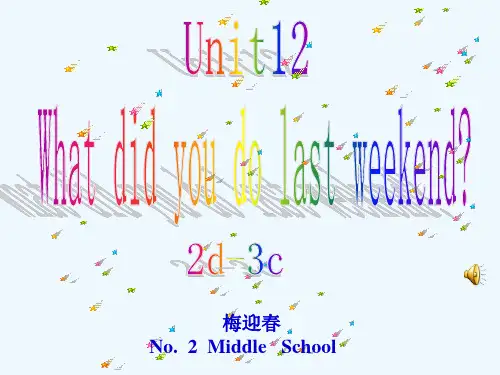



Unit12 SectionB(1a-1e)优质课课件七年级下Unit12. What did you do last weekend?第四课时Section B (1a-1e)Teaching important points:1. Key vocabulary and phrases2. Talk about recent past events.Teaching difficult points:1. Talk about recent past events.2. Practice students' listening, speaking, reading and writing skills.Analysis of the students: The students have learned English for nearly one year so far.They can understand and use some words and some simple sentences. They have taken a great interest in English.Analysis of teaching materials: This unit is from "go for it" for students of Grade 7. The topic of this unit is talking about recent past events. So this unit is very interesting. This is the fourth period of the whole unit. Students would be interested in it. Teaching and learning Goals:1.语言知识及功能:(1)能正确使用下列词汇造句子:fly, kite(2)能正确使用下列短语造句子:do homework, sing and play the guitar, stay at home, study for a test, have dinner with friends, go to the library, fly a kite, swim ina swimming pool, visit my sister(3).能熟练运用下列词汇的一般过去时态完成对话:did, stayed. was, had, studied, went, sang, played, flew, swam, visited(4).能升懂用一般过去时描述的事情,理解其大意,从中获取相关信息。

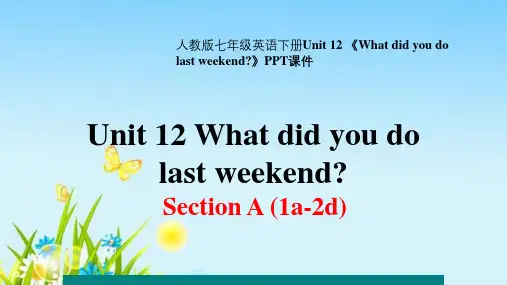
Unit 12 What did you do last weekend?Section A 1 (1a-2d)一、教学目标:1. 语言知识目标:1)掌握以下单词:camp, lake, beach, badminton, sheep, as, natural, butterfly, visitor, tired, stay, stay up late.能掌握以下句型:①— Where did you do last weekend, Lucy?— I went to summer camp.②— How was your weekend?— Pretty good, thanks③— I worked as a guide at the Natural History Museum.④ How interesting!2) 能了解以下语法:learn to talk about recent past events.2. 情感态度价值观目标1. 帮助学生树立合作学习观点。
2. 讲述美好的周末,树立学生享受生活,热爱美好的大自然情感。
二、教学重难点1. 教学重点:1) Key vocabulary.2) Talk about recent past events2. 教学难点:1) Talk about recent past events2) Practice students’ listening, speaking, reading and writing skills.三、教学过程Ⅰ. Warming-up and revisionPoint to the previous Saturday and Sunday on a wall calendar and say, Saturday and Sunday are the weekend. This is last weekend. Then tell some things you did last weekend such as cleaned my house over the weekend. Use quick sketches (in theboard along with gestures to demonstrate the meaning of each activity,Ⅱ. 1 a This activity introduces the key vocabulary.Focus attention on the picture. Ask students to tell what they see. Name each activity and ask students to repeat: did my homework, went to the cinema, went boating, camped by the lake, went to the beach, played badminton.Point out the numbered list of activities. Say each one again and ask students to repeat.Then ask students to match each activity with one of the pictures. Say, Write the letter of each activity next to the words. Point out the sample answer.Check the answers.Ⅲ. ListeningWork on 1bThis activity gives students practice in understanding the target language in spoken conversation.Point to the activities in the picture in activity la. Ask students to tell what the person did in each picture. For example, she played badminton, or Lucy went to the cinema. Play the recording the first time. Students only listen.Play the recording a second time. This time say. Listen to the recording and write the days and times Lucy did each thing under the pictures. Point out the sample answer under the picture of Lucy playing badminton; on Saturday morning.Correct the answers.Ⅳ. PairworkWork on 1cThis activity provides guided oral practice using the target language.Point to the example conversation. Ask two students to read the dialogue to the class.Say, now work with a partner. Student A, pretend to be Lucy. Student B, ask questions about what Lucy did on different days and times over the weekend. Talk about the activities in the picture.Students work in pairs. As they talk, move around the room monitoring their work.Offer language or pronunciation support as needed,Ⅴ. ListeningWork on 2a:This activity gives students practice in understanding the key vocabulary in spoken conversation.Point to the five sentences and ask a student to read these sentences to the class.Say, You will hear recording of a conversation. The people will talk about some of the activities and people, but they will not talk about others. Please underline the words you hear on the recording.Play the recording the first time. Students only listen.Play the recording a second time. This time, ask students to underline each word that is said on the tape. Point out the sample answer, grandmother.Correct the answers.1grandma 2 homework 3 English 4 farm 5 cowsⅥ. ListeningWork on 2b:This activity provides listening practice using the target language.Call attention to the pictures of Carol, Becky, and Jack and ask students to identify each person by name.Say, Now I will play the recording again. Listen to the students talking about what they did over the weekend. Write C for Carol, B for B Becky or J for Jack next to each statement in activity 2a. The first one has been done for you.Play the recording the first time. Students only listen.Point out the sample answer, S, in statement 1. Say, Sonia visited her grandmother.Play the recording again. Ask students to write a letter in front of each statement to show what each person did.Check the answers. B B C J JⅦ. Pair workAsk and answer in pairs.Point to the example conversation. Ask two students to read the dialogue to the class.Say, Now work with a partner. Student A, ask questions about what, who or where, Student B answers. Students work in pairs.Ⅷ. Role-play the conversation.1. Ask Ss to look at conversation in 2d. Then Ss read the dialogue by themselves and find the answer to these questions:① What did Lisa do on her weekend?② What did Paul do on his weekend?2. Ss work in pairs and role-play the conversations.3. Have several pairs perform their conversations for the rest of the class.Homework:1. Copy new words twice.2. Write about what you did last weekend.板书设计:Section A 2 (Grammar Focus-3c)一、教学目标:1. 语言知识目标:1) 掌握以下单词:away, mouse, baby, shout ,shout at, woof, language.2) 继续练习一般过去时态能掌握以下句型:— What did you do last weekend?— I did my homework.— Who visited her grandma?—Becky did.— Where did she go last weekend?— She went to a farm.— Who did she go with?— She went with her classmates.2. 情感态度价值观目标:1. 提高学生独立学习能力。